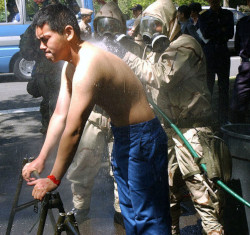Testing for the Effectiveness of Decontamination
Decontamination methods vary in their effectiveness for removing different substances.
The effectiveness of any decontamination method should be assessed at the beginning of a program and periodically throughout the lifetime of the program. If contaminated materials are not being removed or are penetrating protective clothing, the decontamination program must be revised. The following methods may be useful in assessing the effectiveness of decontamination.
- Visual Observation: There is no reliable test to determine immediately how effective decontamination is. In some cases, effectiveness can be estimated by visual observation.
- Natural light: Discolorations, stains, corrosive effects, visible dirt, or alterations in clothing fabric may indicate that contaminants have not been removed. However, not all contaminants leave visible traces; many contaminants can permeate clothing and are not easily observed.
- Ultraviolet light: Certain contaminants, such as polycyclic aromatic hydrocarbons, which are common in many refined oils and solvent wastes, fluoresce and can be visually detected when exposed to ultraviolet light. Ultraviolet light can be used to observe contamination of skin, clothing, and equipment; however, certain areas of the skin may fluoresce naturally, thereby introducing an uncertainty into the test. Also, use of ultraviolet light can increase the risk of skin cancer and eye damage; therefore, a qualified health professional should assess the benefits and risks associated with ultraviolet light before its use at a waste site.
- Wipe Sampling: Wipe testing provides after-the-fact information on the effectiveness of decontamination. In this procedure, a dry or wet cloth, glass fiber filter paper, or swab is wiped over the surface of the potentially contaminated object and then analyzed in a laboratory. Both the inner and outer surfaces of protective clothing should be tested. Skin may also be tested using wipe samples.
- Cleaning Solution Analysis: Another way to test the effectiveness of decontamination procedures is to analyze for contaminants left in the cleaning solutions. Elevated levels of contaminants in the final rinse solution may suggest that additional cleaning and rinsing are needed.
- Testing for Permeation: Testing for the presence of permeated chemical contaminants requires that pieces of the protective garments be sent to a laboratory for analysis.
Knowledge Check Choose the best answer for the question.
12-7. Why should a qualified health professional assess the benefits and risks associated with ultraviolet light before it's used to detect contaminants at a waste site?
You forgot to answer the question!

